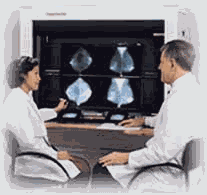A study of nearly 13,000 women confirms previous research that shows computer software helps radiologists detect more breast cancers on mammogram films. The technology, called computer-aided detection (CAD), essentially works like a second pair of eyes, reviewing a woman’s mammogram after the radiologist has made his or her initial interpretation. The latest study shows that approximately 20% more breast cancers can be found with CAD than by radiologists alone. Furthermore, CAD helps detect breast cancers in very early stages, when the chances for successful treatment and survival are the greatest.
All women 40 years of age and older should receive yearly screening mammograms, and younger women at high risk of breast cancer should ask their physicians when they should begin annual mammography. With CAD technology, a computer program scans a woman’s digitized mammogram film after the radiologist has reviewed it. If the computer detects any breast abnormalities or "regions of interest" on the mammogram film, it marks them with a special coding system. The radiologist then reviews the computer markings and decides whether the highlighted areas are indeed abnormalities that need follow-up or if the computer pointed out a normal feature, such as a blood vessel, that is no cause for concern. The final interpretation of the mammogram is still made by the radiologist.
In the newest study on CAD, Timothy W. Freer, MD and Michael J. Ulissey, MD of the Women’s Diagnostic and Breast Health Center in Plano, Texas compared the rate of breast cancer detection with and without CAD on 12,860 mammograms. Each mammogram was first interpreted by a radiologist without CAD assistance and then re-evaluated after CAD marked suspicious areas. In the study, the radiologist alone detected 41 breast cancers, but with the added use of CAD, 49 cancers were ultimately discovered—a 19.5% increase in breast cancer detection. All eight additional cancers detected by CAD were either Stage 0 or Stage I and were easily treatable.

CAD technology helps radiologists detect breast cancer by alerting them to suspicious areas on mammograms. Image courtesy of R2 Technology.
One criticism of the CAD technology has been that it marks a high number of normal breast areas as suspicious which can lead to a greater number of unnecessary breast biopsies. However, in the latest study, Dr. Freer and Dr. Ulissey report that CAD does not significantly increase the rate of breast biopsies. Yet, the researchers emphasize that the radiologist is still the decision-maker and must determine whether the CAD-highlighted area is truly a suspicious abnormality that needs further investigation or whether it is a normal area.
Last November at the annual meeting of the Radiological Society of North America (RSNA), Dr. Freer expressed concern that smaller mammography centers may not be able to afford the costly technology. Currently, the Imagechecker made by R2 Technology is the only CAD system approved by the U.S. Food and Drug Administration (FDA) to help radiologists detect breast cancer. The Imagechecker is available at approximately 200 centers throughout the United States. While Congress recently passed an Act that will provide additional reimbursement for screening mammograms using the CAD technology, many women must currently pay an additional $15 to $20 if they have their mammograms interpreted with CAD assistance.
According to Dr. Freer, further research is still necessary to validate the study’s findings. However, he is optimistic that if future studies confirm his data, CAD could be "the greatest technological leap in early breast cancer detection in the past 20 years." Experts predict that while technology will never replace physicians, it will become increasingly helpful in the diagnosis and treatment of diseases in the future.
- The study, "Computer-Aided Detection (CAD) in Screening Mammography: A Prospective Study of 12,860 Patients in a Community Breast Center," is published in the September 1, 2001 issue of Radiology, http://radiology.rsnajnls.org/
- The November 30, 2000 Imaginis report, "Computer-Aided Detection Technology May Help Improve Accuracy of Mammograms," is available at http://www.imaginis.com/breasthealth/news/news11.30.00.asp
- R2 Technology, the maker of the Imagechecker, provides information on CAD, including a list of locations where CAD is available, at http://www.r2tech.com/
- To learn more about CAD, please visit http://www.imaginis.com/breasthealth/cad.asp



